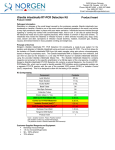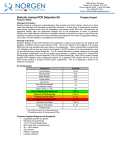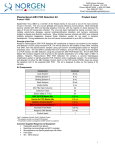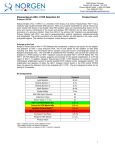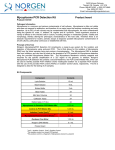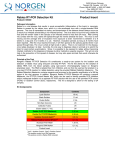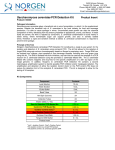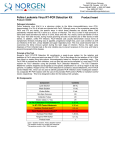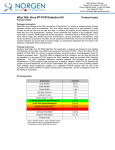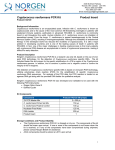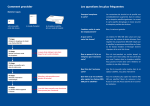Download Cryptosporidium RT-PCR Detection Kit
Transcript
3430 Schmon Parkway Thorold, ON, Canada L2V 4Y6 Phone: 866-667-4362 • (905) 227-8848 Fax: (905) 227-1061 Email: [email protected] Cryptosporidium RT-PCR Detection Kit Product Insert Product # 39100 Pathogen Information Cryptosporidium is a parasite found in water that causes an infection in mammals termed cryptosporidiosis. It is one of the most common water-bourne diseases and is found world-wide. It affects the intestines of mammals and typically causes an acute short-term infection. The most common symptom is self-limiting diarrhea in healthy individuals, however in immunocompromised individuals the symptoms are particularly severe and often fatal. There is no specific treatment for cryptosporidiosis other than fluid rehydration and management of any pain. Therefore early detection of Cryptosporidium in water is the foremost action to prevent the infection. Principle of the Test Norgen’s Cryptosporidium RT- PCR Detection Kit constituents a ready-to-use system for the isolation and detection of Cryptosporidium using end-point one step RT-PCR. The kit first allows for the isolation of Cryptosporidium RNA from the water samples using spin-column chromatography based on Norgen’s proprietary resin. The Cryptosporidium RNA is isolated free from inhibitors, and can then be used as the template in a one step RT-PCR reaction for Cryptosporidium detection using the provided Cryptosporidium Master Mix. The Cryptosporidium Mastermix contains reagents and enzymes for the specific amplification of a 218 bp region of the viral genome. In addition, Norgen’s Cryptosporidium RT-PCR Detection Kit contains a second Mastermix, the Control 2X RT-PCR Master Mix, which can be used to identify possible PCR inhibition and/or inadequate isolation via a separate RT-PCR reaction with the use of the provided PCR control (PCRC) or Isolation Control (IsoC), respectively. This kit is designed to allow for the testing of 24 samples. Kit Components: Component Contents Lysis Solution 25 mL Wash Solution 11 mL Elution Buffer 2 mL Bead Tubes 24 Mini Spin Columns 24 Collection Tubes 24 Elution tubes (1.7 mL) 24 CRYP 2x RT-PCR Master Mix 0.35 mL Control 2x RT-PCR Mastermix 0.35 mL a Isolation Control (IsoC)* 0.3 mL b CRYP Positive Control (PosC)* 0.1 mL Nuclease Free-Water 1.25 mL Norgen’s DNA Marker 0.1 mL Product Insert 1 * IsoC = Isolation Control ; PosC= Positive Control a b The isolation control is a cloned PCR product. The positive control is Cryptosporidium RNA transcript Customer-Supplied Reagents and Equipment • Benchtop microcentrifuge • 1.5 mL microcentrifuge tubes • 96 – 100% ethanol • 70% ethanol Storage Conditions and Product Stability • • • • The CRYP 2X Detection RT-PCR Mastermix (green cap) and the Control 2X RT-PCR Mastermix (yellow cap) should be stored at -20°C upon receipt (-70°C for long-term). Make appropriate aliquots and store at -20°C if needed. All other kit components may be stored at room temperature The CRYP 2X Detection RT-PCR Mastermix and the Control 2X RT-PCR Mastermix, Positive Control and Isolation Control should not undergo repeated freeze-thaw (a maximum freeze-thaw of three times). For RT-PCR • Allow reagents to thaw at room temperature prior to use • When thawed, mix the components and centrifuge briefly • Work quickly on ice • After addition of RT-PCR Mastermix use within one hour General Precautions The user should exercise the following precautions when using the kit: • Use sterile pipette tips with filters. • Store and extract positive material (specimens, controls and amplicons) separately from all other reagents and add it to the reaction mix in a spatially separated facility. • Thaw all components thoroughly at room temperature before starting an assay. • When thawed, mix the components and centrifuge briefly. • Work quickly on ice. Quality Control In accordance with Norgen’s ISO 9001 and ISO 13485-certified Quality Management System, each lot of Norgen’s CRYP RT-PCR Detection Kit, including the CRYP 2x RT-PCR Master Mix, Control 2X RTPCR Mastermix, Isolation Control and CRYP Positive Control are tested against predetermined specifications to ensure consistent product quality. Product Use Limitations Norgen’s Cryptosporidium RT-PCR Detection Kit is designed for research purposes only. Product Warranty and Satisfaction Guarantee NORGEN BIOTEK CORPORATION guarantees the performance of all products in the manner described in our product manual. The customer must determine the suitability of the product for its particular use. Safety Information Ensure that a suitable lab coat, disposable gloves and protective goggles are worn when working with chemicals. For more information, please consult the appropriate Material Safety Data Sheets (MSDSs). These are available as convenient PDF files online at www.norgenbiotek.com. CAUTION: DO NOT add bleach or acidic solutions directly to the sample-preparation waste. Working with RNA RNases are very stable and robust enzymes that degrade RNA. Autoclaving solutions and glassware is not always sufficient to actively remove these enzymes. The first step when preparing to work with RNA is to create an RNase-free environment. The following precautions are recommended as your best defense against these enzymes. • • • • • • The RNA area should be located away from microbiological work stations. Clean, disposable gloves should be worn at all times when handling reagents, samples, pipettes, disposable tubes, etc. It is recommended that gloves are changed frequently to avoid contamination. There should be designated solutions, tips, tubes, lab coats, pipettes, etc. for RNA only. All RNA solutions should be prepared using at least 0.05% DEPC-treated autoclaved water or molecular biology grade nuclease-free water. Clean all surfaces with commercially available RNase decontamination solutions. When working with purified RNA samples, ensure that they remain on ice during downstream applications. Protocol A. Cryptosporidium Total RNA Isolation Important Notes Prior to Beginning Protocol: • 0.22 or 0.45 µM Filter Columns (please see Related Products table) must be purchased separately and used with this procedure. Users may also provide their own Filter Columns. • All centrifugation steps are carried out in a benchtop microcentrifuge at 14,000 x g (~ 14,000 RPM) except where noted. All centrifugation steps are performed at room temperature. • A variable speed microcentrifuge should be used for maximum kit performance. If a variable speed centrifuge is not available a fixed speed centrifuge can be used, however reduced yields may be observed. • Ensure that all solutions are at room temperature prior to use. • Prepare a working concentration of the Wash Solution by adding 25 mL of 95 - 100 % ethanol (provided by the user) to the supplied bottle containing the concentrated Wash Solution. This will give a final volume of 36 mL. The label on the bottle has a box that may be checked to indicate that the ethanol has been added. o • • • • • • Pre-heat a water bath or an incubator to 65 C For optimal kit performance we recommend processing 10 mL to 100 mL of water through Norgen’s Filter Columns (sold separately, see related product table), depending on the sample. For clear water samples, the maximum input of 100 mL can be processed. For turbid water samples we recommend processing smaller volumes, as the suspended solids or sediment may clog the filter. It is important to work quickly when purifying RNA. Cryptosporidium Isolation Control (IsoC) A CRYP Isolation Control (IsoC) is supplied. This allows the user to control the RNA isolation procedure. For this assay, add the CRYP Isolation Control (IsoC) to the lysate during the isolation procedure The CRYP Isolation Control (IsoC) must not be added to the sample material directly. Do not freeze and thaw the CRYP Isolation Control (IsoC) more than 2 times. The CRYP Isolation Control (IsoC) must be kept on ice at all times during the isolation procedure. The RT-PCR components of the Cryptosporidium RT-PCR Detection Kit should remain at -20oC until RNA is extracted and ready for RT-PCR amplification. It is important to work quickly during this procedure. 1. Lysate Preparation using a Vacuum Apparatus a. Obtain a water sample that is 10 mL – 100 mL, depending on the water source (see Notes Prior to Use above). b. Place the Filter Column (Sold separately, see related product table) onto a vacuum apparatus. c. Transfer up to 20 mL of water to the filter and allow the total volume to pass. This may be repeated as required in order to allow the entire water sample (up to 100 mL) to pass through the filter. d. Cut the filter out by running a sterile scalpel blade along with edge of O-ring, located on top of the filter. Alternatively, remove the O-ring from the filter column by using tissue forceps which have 1x2 teeth (e.g. VWR Tissue forceps Cat. No. 25607-608). e. Carefully remove the filter from the filter column using sterile forceps, and transfer to a provided Bead Tube. Note: Remove the filter by picking it up by the edges/corner. Avoid touching the center of the filter. Ensure when placing the filter into the Bead Tube that the upper surface of the filter is facing the center of the tube. f. Add 500 µL of Lysis Solution to the Bead Tube and secure the tube horizontally on a flatbed vortex pad with tape, or in any commercially available bead beater equipment (e.g. TM Scientific Industries’ Disruptor Genie ). Vortex for 5 minutes at maximum speed. Note: The appearance of some white foam during the homogenization is common. This is due to detergents present in the Lysis Buffer and will not affect the protocol. o g. Incubate at 65 C for 10 minutes. Occasionally mix the lysate 2 or 3 times during incubation by inverting the tube. Ensure that the filter does not become dry. h. Centrifuge the tube for 1 minute at 14000 × g (~14,000 RPM). i. Transfer the lysate to another RNase-free microcentrifuge tube (provided by the user). Note the volume. j. Add an equal volume of 70% ethanol (provided by the user) to the lysate collected above (100 µL of ethanol is added to every 100 µL of lysate). Vortex to mix. Proceed to Step 2. 2. Binding Nucleic Acids to Column a. Assemble a spin column with one of the provided collection tubes. b. Add 10 µL of Isolation Control (IsoC) to the lysate mixture. c. Apply up to 600 µL of the lysate with ethanol onto the column and centrifuge for 1 minute at 14,000 x g (~14,000 RPM). Discard the flowthrough and reassemble the spin column with the collection tube Note: Ensure the entire lysate volume has passed through into the collection tube by inspecting the column. If the entire lysate volume has not passed, spin for an additional minute. d. Depending on your lysate volume, repeat step 2c if necessary. 3. Column Wash a. Apply 500 µL of Nucleic Acid Wash Solution to the column and centrifuge for 1 minute. Note: Ensure the entire wash solution has passed through into the collection tube by inspecting the column. If the entire wash volume has not passed, spin for an additional minute. b. Discard the flowthrough and reassemble the column with its collection tube. c. Repeat step 3a to wash column a second time. d. Discard the flowthrough and reassemble the spin column with its collection tube. e. Spin the column for 2 minutes in order to thoroughly dry the resin. Discard the collection tube. 4. RNA Elution a. Place the column into a fresh 1.7 mL Elution tube provided with the kit. b. Add 50 µL of Elution Buffer to the column. c. Centrifuge for 2 minutes at 200 x g (~2,000 RPM), followed by a 1 minute spin at 14,000 x g (~14,000 RPM). Note the volume eluted from the column. If the entire volume has not been eluted, spin the column at 14,000 x g (~14,000 RPM) for 1 additional minute. d. The purified RNA sample could be used immediately for RT-PCR as described below. It is recommended that samples be placed at -70°C for long term storage. 5. Storage of DNA and RNA The purified nucleic acids may be stored at –20°C for a few days. It is recommended that samples be placed at –70°C for long term storage. B. Cryptosporidium RT-PCR Assay Preparation Notes: • Before use, suitable amounts of all RT-PCR components should be completely thawed at room temperature, vortexed and centrifuged briefly. • The amount of Cryptosporidium 2X RT-PCR Master Mix provided is enough for up to 32 RT-PCR reactions (24 sample RT-PCR, 4 positive control RT-PCR and 4 no template control RT-PCR). • For each sample, one RT-PCR reaction using the Cryptosporidium 2X Detection RT-PCR Mastermix and one RT-PCR reaction using Control 2X RT-PCR Mastermix should be set up in order to have a proper interpretation of the results. • For every RT-PCR run, one reaction containing Cryptosporidium Positive Control (CRYP PosC) and one reaction as no template control (Nuclease Free-Water) must be included for proper interpretation of results. • The recommended minimum number of RNA samples tested per RT-PCR run is 6. • Using a lower volume from the sample than recommended may affect the sensitivity of Cryptosporidium Limit of Detection. 1. Prepare the RT-PCR reaction for sample detection (Set #1, using CRYP 2X Detection RT-PCR Mastermix) and the RT-PCR reaction for control detection (Set #2, using Control 2X RT-PCR Mastermix) as shown in Table 1 below. The recommended amount of sample RNA to be used is 2 µL. Ensure that one Cryptosporidium detection reaction and one control reaction is prepared for each RNA sample. Adjust the final volume of the RT-PCR reaction to 20 µL using the NucleaseFree Water provided. Table 1. RT-PCR Assay Preparation RT-PCR Components Volume Per RT-PCR Reaction CRYP 2X RT-PCR Master Mix Or Control 2X RT-PCR Master Mix 10 µL Sample RNA 2 µL Nuclease-Free Water 8 µL Total Volume 20 µL 2. For every RT-PCR run, prepare one positive control RT-PCR as shown in Table 2 below: Table 2. RT-PCR Positive Control Preparation RT-PCR Components Volume Per RT- PCR Reaction CRYP 2X RT-PCR Master Mix Or Control 2X RT-PCR Master Mix 10 µL CRYP Positive Control (PosC) 10 µL Total Volume 20 µL 3. For every RT- PCR run, prepare one no template control RT-PCR as shown in Table 3 below: Table 3. RT-PCR Negative Control Preparation RT-PCR Components Volume Per RT-PCR Reaction CRYP 2X RT- PCR Master Mix Or Control 2X RT-PCR Master Mix 10 µL Nuclease-Free Water 10 µL Total Volume 20 µL Therefore, at a minimum, each PCR run will contain 6 separate RT-PCR reactions. C. One Step RT- Cryptosporidium PCR Assay Programming 1. Program the thermocylcer according to the program shown in Table 4 below. 2. Run one step RT-PCR. Table 4. Cryptosporidium Assay Program One Step RT-PCR Cycle Cycle 1 Cycle 2 Step Step 1 Step 1 Step 1 Cycle 3 (40x) Cycle 4 Cycle 5 Temperature Duration o 30 min o 3 min o 15 sec o 50 C 95 C 94 C Step 2 60 C 30 sec Step 3 72oC 45 sec o Step 1 72 C Step 1 o 4C 5 min ∞ D. Cryptosporidium One Step RT- PCR Assay Results Interpretation 1. For the analysis of the RT-PCR data, the entire 15-20 µL RT-PCR Reaction should be loaded on a 1X TAE 1.5% Agarose RNA gel along with 10 µL of Norgen’s DNA Marker (provided). 2. The RT-PCR products should be resolved on the 1X TAE 1.5% Agarose gel at 150V for 20 minutes (Gel running time will be vary depending on an electrophoresis apparatus). 3. Sample results are provided below: M 1 2 3 4 2000 1500 1000 750 500 300 CRYP Target 150 50 Figure 1: A representative 1X TAE 1.5% agarose gel showing the amplification of CRYP positive (lane 1 and 2) negative (lane 3 and 4) controls. The size of the CRYP target amplicon corresponds to 218 bp as represented by the provided DNA Marker (M). 1 2 3 4 5 6 7 8 M Isolation control PCR control Figure 2: A representative 1X TAE 1.5% agarose gel showing the amplification of Isolation Control and PCR Control under different conditions using the Control 2X RT-PCR Mastermix. The size of the Isolation Control amplicon and PCR Control amplicon correspond to 499 bp and 150 bp, respectively, as represented by the provided DNA Marker (M). Lanes 1 to 6 showed detection of both Isolation Control and PCR Control, suggesting that the RNA isolation as well as the RT-PCR reaction was successful. Lane 7 and 8 showed only the detection of PCR Control suggesting that while the RT-PCR was successful, the isolation failed to recover even the spiked-in Isolation control. Table 5. Interpretation of One Step RT-PCR Assay Results Target Reaction Control Reaction Input Type Interpretation CRYP Target CRYP IsoC CRYP PCRC Band (218 bp) Band (499 bp) Band (150 bp) X X X Valid X X Valid X X Positive Sample X X Negative Sample X Positive Control Negative Control Sample X Sample X Sample X Sample X Negative X X Positive Positive Positive ** For results obtained that are not covered in Table 5 above, please refer to the Troubleshooting Section. E. Cryptosporidium RT-PCR Assay Specificity and Sensitivity • The specificity of Norgen’s Cryptosporidium RT-PCR Detection Kit is first and foremost ensured by the selection of the Cryptosporidium -specific primers, as well as the selection of stringent reaction conditions. The Cryptosporidium universal primers were checked for possible homologies to all in GenBank published sequences by sequence comparison analysis and published Cryptosporidium strains. F. Linear Range • • • • The linear range of Norgen’s Cryptosporidium RT-PCR Detection Kit was determined by analysing a dilution series of a Cryptosporidium quantification standards ranging from 100 ag to 1 pg. Each dilution has been tested in replicates (n = 4) using Norgen’s Cryptosporidium RT-PCR Detection Kit on a 1X TAE 1.7% agarose gel. The linear range of Norgen’s Cryptosporidium RT-PCR Detection Kit has been determined to cover concentrations from 100 ag to 1 ng Under the conditions of the Norgen’s Cryptosporidium RNA Isolation procedure, Norgen’s Cryptosporidium RT-PCR Detection Kit covers a linear range from 100 copies to 1 x 106 copies. Frequently Asked Questions 1. How many samples should be included per RT-PCR run? • Norgen’s Cryptosporidium RT-PCR Detection Kit is designed to test 24 samples. For every 6 samples, a non-template control (Nuclease Free Water) and a Positive Control must be included. It is preferable to pool and test 6 samples at a time. If not, the provided Positive Control is enough to run 3 samples at a time. 2. How can I interpret my results if neither the Cryptosporidium RT-PCR control nor the Isolation Control (IsoC) amplifies? • If neither the Cryptosporidium PCR control nor the Isolation Control (IsoC) amplifies, the sample must be re-tested. If the positive control showed amplification, then the problem occurred during the isolation, where as if the Positive control did not amplify, therefore the problem has occurred during the setup of the PCR assay reaction. 3. How should it be interpreted if only the Cryptosporidium PCR control showed amplification but neither the Cryptosporidium target nor the Isolation control amplified for a sample? • This indicates a poor isolation. The isolation procedure must be repeated. 4. How should it be interpreted if only the Isolation Control (IsoC) was amplified in a sample? • The sample tested can be considered as Cryptosporidium negative. 5. How should it be interpreted if the Cryptosporidium PCR control and the Cryptosporidium target showed amplification in a sample? • The sample tested can be considered positive. It could happen when too much template was added to the reaction. 6. How should it be interpreted if only the Cryptosporidium target and the Cryptosporidium PCR control were amplified in a sample? • The sample tested can be considered as Cryptosporidium positive. 7. How should it be interpreted if only the Cryptosporidium target was amplified in a sample? • The sample tested should be considered as Cryptosporidium positive. At high Cryptosporidium input, the Cryptosporidium amplicon will be predominant and thus the Cryptosporidium PCR control as well as the Isolation control may not amplify as they compete for PCR resources. 8. How should it be interpreted if only the Cryptosporidium PCR control and the Isolation control showed amplification in a sample? • The sample tested can be considered negative 9. What if I forgot to do a dry spin after my third wash? • Your first RNA elution will be contaminated with the Wash Solution. This may dilute the RNA yield in your first elution and it may interfere with the PCR detection, as ethanol is known to be a PCR inhibitor. 10. What if I forgot to add the Isolation Control (IsoC) during the isolation? • It is recommended that the isolation is repeated. Related Products Product # Water RNA/DNA Purification Kit (0.45 µm) 0.45 µm Filter Maxi Columns (20/bag) Water RNA/DNA Purification Kit (0.22 µm) 0.22 µm Filter Maxi Columns (20/bag) 26450 40006 26400 40004 Technical Assistance NORGEN’s Technical Service Department is staffed by experienced scientists with extensive practical and theoretical expertise in sample and assay technologies and the use of NORGEN products. If you have any questions or experience any difficulties regarding Norgen’s Urine RNA Isolation Mini Kit (Slurry Format) or NORGEN products in general, please do not hesitate to contact us. NORGEN customers are a valuable source of information regarding advanced or specialized uses of our products. This information is helpful to other scientists as well as to the researchers at NORGEN. We therefore encourage you to contact us if you have any suggestions about product performance or new applications and techniques. For technical assistance and more information, please contact our Technical Support Team between the hours of 8:30 and 5:30 (Eastern Standard Time) at (905) 227-8848 or Toll Free at 1-866-667-4362 or call one of the NORGEN local distributors (www.norgenbiotek.com) or through email at [email protected]. 3430 Schmon Parkway, Thorold, ON Canada L2V 4Y6 Phone: (905) 227-8848 Fax: (905) 227-1061 Toll Free in North America: 1-866-667-4362 ©2011 Norgen Biotek Corp. PI39100-5










